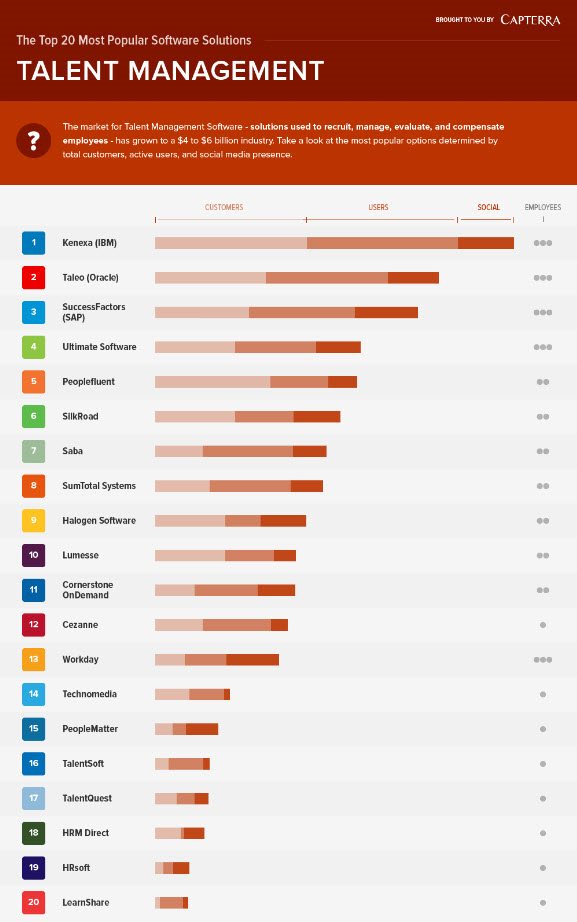Ranking Talent Management Vendors vs Personalities

In the infographic and accompanying article (below), the talent management systems are ranked in order of users, customers, compete rank and social, which includes Twitter, Facebook, LinkedIn and Klout. Capterra whittles the list down to twenty from a much larger list and has an entire post dedicated to explaining its methodology and why they are doing these posts.
What makes it interesting is that when companies like Traackr, HRExaminer, FistfulofTalent and HRMarketer attempted these lists about personalities (consultants, bloggers, actual recruiters or HR practitioners) they got a great deal of pushback from the ever growing community, those who believed that online influence was something that was not only difficult to measure, but basing someone’s professional credibility on such was a fool’s errand and by its very nature, excluded hard working professionals who hadn’t the time to game Twitter or post on Facebook all day.
So one of the things that makes this list by Capterra interesting (for something more robust, see Laroque’s #hrwins briefings ) is that it combines seemingly very real numbers around users and customers that personalities rarely have to provide and can or might embellish.
However, even Capterra’s methodology post points out that all vendors report their user numbers differently and several of the companies on their list (Cornerstone for one) reported additional numbers after an acquisition that may have changed their “ranking” in the top 20 had it been figured into the algorithm.
While none of the companies on the list are startups, it also occurs to me that customers rely heavily on the assumption that they are “paying” customers, numbers which could differ from the total customer number on the tin.
Like any Top fill-in-the-blank List, you do have to include social simply to get a solid idea of whether or not social sales and service is actually working. One of the interesting findings here was that many of the companies are beefing up their social interactions with customers, users and followers by significant numbers. While this may not be a trend that is unique to HR technology, it’s still significant that social sales, or at least a burgeoning bud of such, is taking hold in the vendor marketplace.
Something that we noticed when doing the LMS research, but didn’t really mention was the enormous rate of growth of the social media numbers for these software vendors. During our research a few vendors mentioned they didn’t understand how the social media really played into our data compilation, but let me tell you, at the rate these numbers are increasing, it matters, a lot.
The flip side of that is that these companies are almost certainly employing marketing pros to bolster their social media presence, which was another complaint when early personality lists were distributed. Many were offended that bloggers and consultants were using follower tools or gaming the Klout bots to attain higher scores, visibility and a following. But corporately, it appears that it’s okay. The score that balances this out is the listing or figuring in of a compete ranking, which essentially shows how much targeted traffic the website receives.
Have we finally figured out that social numbers must be compared and contrasted with user numbers and real sales or customer data to make a significant contribution to ranking players in any field (whether it’s consultants and bloggers or large multinational corporations)? While this graphic is simple and not a perfect solution to rankings, we are getting closer. The same can be said for some recent changes to Klout, adding research papers and publications to LinkedIn and the much grumbled about diminished marketing capacity on Facebook. While none of these are perfect enhancements, they all speak to a desire to make these lists hit closer to reality and inform consuming decisions, instead of stroking egos.


